Christopher alexander - A pattern language
Здесь есть возможность читать онлайн «Christopher alexander - A pattern language» весь текст электронной книги совершенно бесплатно (целиком полную версию без сокращений). В некоторых случаях можно слушать аудио, скачать через торрент в формате fb2 и присутствует краткое содержание. Жанр: Прочая научная литература, на английском языке. Описание произведения, (предисловие) а так же отзывы посетителей доступны на портале библиотеки ЛибКат.
- Название:A pattern language
- Автор:
- Жанр:
- Год:неизвестен
- ISBN:нет данных
- Рейтинг книги:3 / 5. Голосов: 1
-
Избранное:Добавить в избранное
- Отзывы:
-
Ваша оценка:
- 60
- 1
- 2
- 3
- 4
- 5
A pattern language: краткое содержание, описание и аннотация
Предлагаем к чтению аннотацию, описание, краткое содержание или предисловие (зависит от того, что написал сам автор книги «A pattern language»). Если вы не нашли необходимую информацию о книге — напишите в комментариях, мы постараемся отыскать её.
A pattern language — читать онлайн бесплатно полную книгу (весь текст) целиком
Ниже представлен текст книги, разбитый по страницам. Система сохранения места последней прочитанной страницы, позволяет с удобством читать онлайн бесплатно книгу «A pattern language», без необходимости каждый раз заново искать на чём Вы остановились. Поставьте закладку, и сможете в любой момент перейти на страницу, на которой закончили чтение.
Интервал:
Закладка:
r. For local trips, people use a variety of low-speed, low-cost vehicles (bicycles, tricycles, scooters, golf carts, bicycle buggies, horses, etc.), which take up less room than cars and which all leave their passengers in closer touch with their environment and with one another.
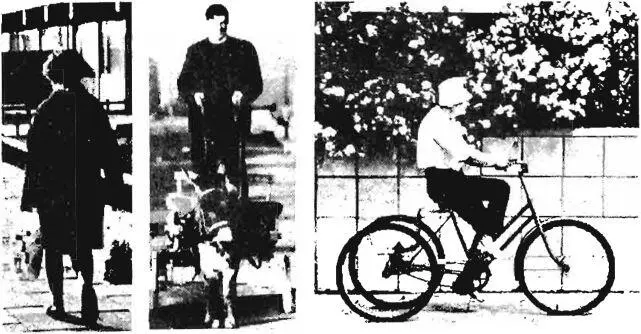 |
| Many ways of getting around on local trifs. |
2. People still own, and use, cars and trucks—but mainly for long trips. We assume that these cars can be made to be quiet, nonpolluting, and simple to repair, and that people simply consider them best suited for long distance travel. It will still be possible for people to use a car or a truck for a local trip, either in a case of emergency, or for some special convenience. However, the town is constructed in such a way that it is actually expensive and inconvenient to use cars for local trips—so that people only do it when they are willing to pay for the very great social costs of doing so.
pear altogether. Four inch steel pipes or 6 inch reinforced concrete columns break up space, but they destroy it as a place for human action, because they do not create “spots” where people can be comfortable.
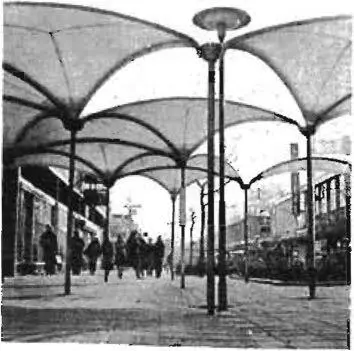 |
| Thin columns of the flastic world. |
In these times, it is therefore necessary to reintroduce, consciously, the social purposes which columns have, alongside their structural functions. Let us try to define these social purposes exactly.
A column affects a volume of space around it, according to the situation. The space has an area that is roughly circular, perhaps 5 feet in radius.
\
I
*
\
M‘ -
5 ’ 1
The sface around the column.
When the column is too thin, or lacks a top or bottom, this entire volume—an area of perhaps 75 square feet—is lost. It cannot be a satisfactory place in its own right: the column is too thin to lean against, there is no way to build a seat up against it, there is no natural way to place a table or a chair against the column. On the other hand, the column still breaks up the space. It subtly prevents people from walking directly through that area: we notice
1066
that people tend to give these thin columns a wide berth; and it prevents people from forming groups.
In short, if the column has to be there, it will destroy a considerable area unless it is made to be a place where people feel comfortable to stay, a natural focus, a place to sit down, a place to lean.
Therefore:
When a column is free standing, make it as thick as a man—at least 12 inches, preferably 16 inches: and form places around it where people can sit and lean comfortably: a step, a small seat built up against the column, or a space formed by a pair of columns.
 |
| thick columns |
You can get the extra thickness quite cheaply if you build the column as a box column (216); complete the “place” the column forms, by giving it a “roof” in the form of a column capital, or vault which springs from the column, or by bracing the column against the beams-—column connection (227). And when it makes sense, make the column base a sitting wall (243), a place for flowers—raised flowers (245), or a place for a chair or table-DIFFERENT CHAIRS (25 1). . . .
227 COLUMN CONNECTIONS**
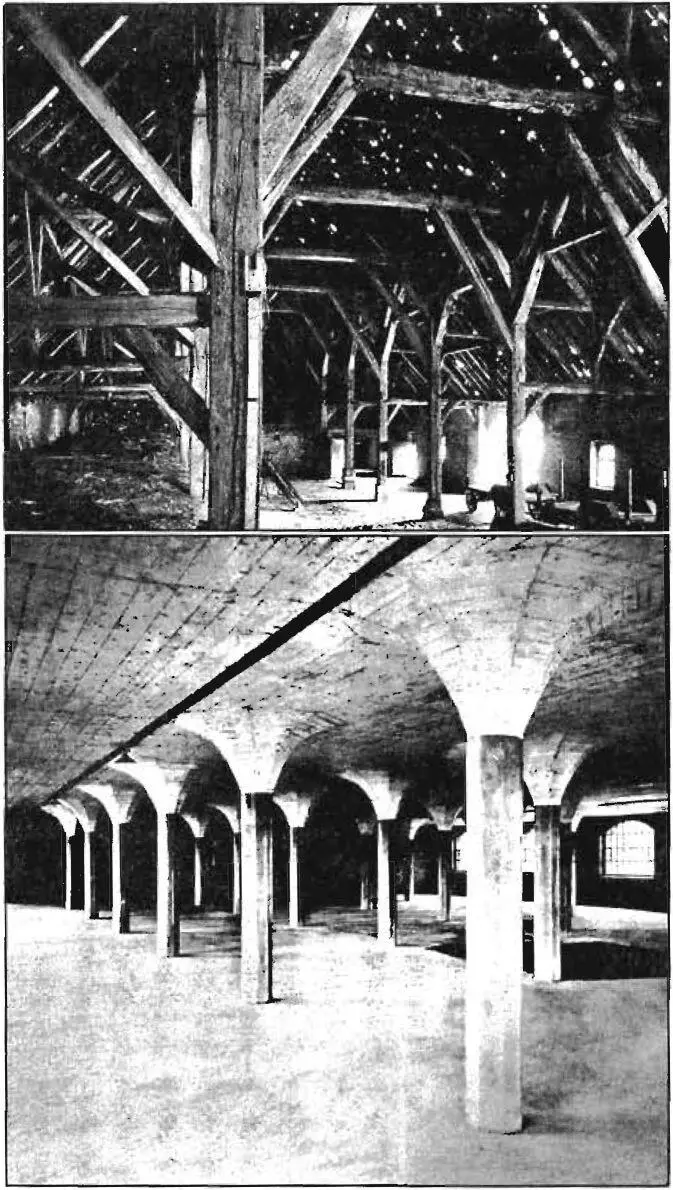 |
| 1068 |
. . . the columns are in position, and have been tied together by a perimeter beam—box columns (216), perimeter beams
(217). According to the principles of continuity which govern the basic structure—efficient structure (206), the connections need stiffening to lead the forces smoothly from the beams into the columns, especially when the columns are free standing as they are in an arcade or balcony—arcade ( i i 9), gallery surround (166), SIX-FOOT BALCONY (167), COLUMN PLACE (226). You may also do the same in the upper corners of your door and window frames—frames as thickened edges (225)—making arched openings.
•5*
The strength of a structure depends on the strength of its connections; and these connections are most critical of all at corners, especially at the corners where the columns meet the beams.
There are two entirely different ways of looking at a connection:
1. As a source of rigidity, which can be strengthened by triangulation, to prevent racking of the frame. This is a moment connection: a brace. See the upper picture.
2. As a source of continuity, which helps the forces to flow easily around the corner in the process of transferring loads by changing the direction of the force. This is a continuity connection: a capital. See the lower picture.
x. A column connection as a brace.
As a building is erected, and throughout its life, it settles, creating tiny stresses within the structure. When the settling is uneven, as it most always is, the stresses are out of balance; there is strain in every part of the building, whether or not that part of the building was designed to accept strain and transmit the forces on down to the ground. The parts of the building that are not designed to carry these forces become the weak points of the building subject to fracture and rupture.
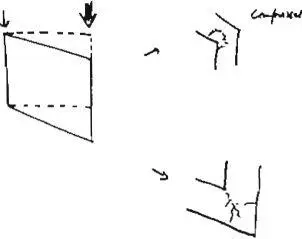
Effects of uneven stresses on a frame.
Rectangular frames, especially, have these cracks at the corners because the transmission of the load is discontinuous there. To solve this problem the frame must be braced—made into a rigid frame that transmits the forces around it as a whole without distorting. The bracing is required at any right-angled corner between columns and beams or in the corners of door and window frames.
2. A column connection as a capital.
This happens most effectively in an arch. The arch creates a continuous body of compressive material, which transfers vertical forces from one vertical axis to another. It works effectively because the line of action of a vertical force in a continuous compressive medium spreads out downward at about 45 degrees.
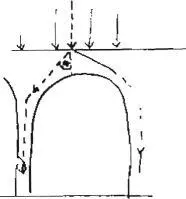
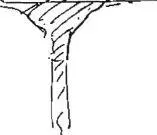
And a column capital is, in this sense, acting as a small, underdeveloped arch. It reduces the length of the beam—and so reduces bending stress. And it begins to provide the path for the forces as they move from one vertical axis to another, through the medium of the beam. The larger the capital, the better.
A capital that acts the same vuay as an arch.
Читать дальшеИнтервал:
Закладка:
Похожие книги на «A pattern language»
Представляем Вашему вниманию похожие книги на «A pattern language» списком для выбора. Мы отобрали схожую по названию и смыслу литературу в надежде предоставить читателям больше вариантов отыскать новые, интересные, ещё непрочитанные произведения.
Обсуждение, отзывы о книге «A pattern language» и просто собственные мнения читателей. Оставьте ваши комментарии, напишите, что Вы думаете о произведении, его смысле или главных героях. Укажите что конкретно понравилось, а что нет, и почему Вы так считаете.












